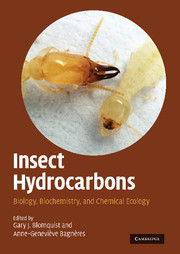Book contents
- Frontmatter
- Contents
- List of contributors
- Foreword
- Acknowledgments
- Part I Chemistry, Biochemistry, and Physiology
- Part II Chemical Communication
- 10 Perception and olfaction of cuticular compounds
- 11 Nestmate recognition in social insects and the role of hydrocarbons
- 12 Cuticular hydrocarbon cues in the formation and maintenance of insect social groups
- 13 Hydrocarbon profiles indicate fertility and dominance status in ant, bee, and wasp colonies
- 14 Chemical deception/mimicry using cuticular hydrocarbons
- 15 Behavioral and evolutionary roles of cuticular hydrocarbons in Diptera
- 16 Contact recognition pheromones in spiders and scorpions
- 17 Hydrocarbons as contact pheromones of longhorned beetles (Coleoptera: Cerambycidae)
- 18 Polyene hydrocarbons, epoxides, and related compounds as components of lepidopteran pheromone blends
- 19 Volatile hydrocarbon pheromones from beetles
- 20 Future directions in hydrocarbon research
- Index
12 - Cuticular hydrocarbon cues in the formation and maintenance of insect social groups
from Part II - Chemical Communication
Published online by Cambridge University Press: 18 May 2010
- Frontmatter
- Contents
- List of contributors
- Foreword
- Acknowledgments
- Part I Chemistry, Biochemistry, and Physiology
- Part II Chemical Communication
- 10 Perception and olfaction of cuticular compounds
- 11 Nestmate recognition in social insects and the role of hydrocarbons
- 12 Cuticular hydrocarbon cues in the formation and maintenance of insect social groups
- 13 Hydrocarbon profiles indicate fertility and dominance status in ant, bee, and wasp colonies
- 14 Chemical deception/mimicry using cuticular hydrocarbons
- 15 Behavioral and evolutionary roles of cuticular hydrocarbons in Diptera
- 16 Contact recognition pheromones in spiders and scorpions
- 17 Hydrocarbons as contact pheromones of longhorned beetles (Coleoptera: Cerambycidae)
- 18 Polyene hydrocarbons, epoxides, and related compounds as components of lepidopteran pheromone blends
- 19 Volatile hydrocarbon pheromones from beetles
- 20 Future directions in hydrocarbon research
- Index
Summary
Insect social groups are formed and maintained by the many interactions among the members of the system (Gordon, 1996; Deneubourg et al., 2002; O'Donnell and Bulova, 2007). Some solitary insect species are gregarious, forming self-organized aggregations associated with protection, reproduction, and feeding (Wertheim et al., 2005). Eusocial insects live in societies with a division of labor between a reproductive caste and sterile workers in which the activity of workers is regulated in a non-hierarchical manner (Gordon, 1996). Patterns of social interaction can inform individual behavioral decisions that, in the aggregate, lead to changes in group dynamics. Many insect species use information coded in cuticular hydrocarbons to recognize other individuals during social interactions.
Aggregations of adult and nymph desert locusts (Schistocerca gregaria) are triggered by plant chemical attractants and aggregation pheromones (Heifetz et al., 1997). This increase in population density results in an increase in direct contact and close-range chemical interactions among individuals. The increase in density subsequently induces a behavioral transition from a solitary phase to a gregarious migratory phase of behavior in which locusts become more active and interact with each other more (Heifetz et al., 1996). Behavioral and physiological data show that cuticular lipids, specifically the hydrocarbon fraction, are responsible for the transition to the gregarious phase (Heifetz et al., 1997, 1998). As locusts interact at high density, cues in cuticular hydrocarbons are detected by the antennae. Hydrocarbons from S. gregaria have been shown to interact with antennal receptors which affect levels of the second messenger inositol triphosphate (Heifetz et al., 1997).
- Type
- Chapter
- Information
- Insect HydrocarbonsBiology, Biochemistry, and Chemical Ecology, pp. 244 - 253Publisher: Cambridge University PressPrint publication year: 2010
- 10
- Cited by



